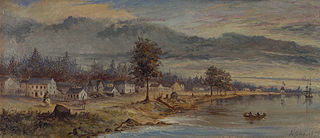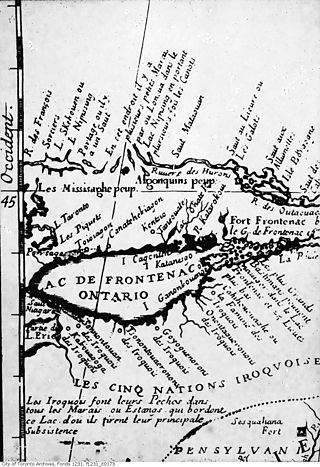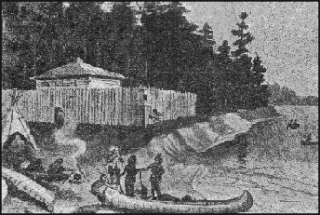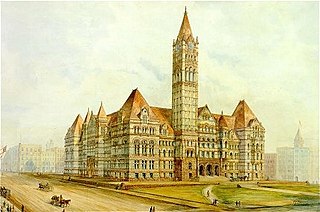Related Research Articles

Pierre Gaultier de Varennes, sieur de La Vérendrye was a French Canadian military officer, fur trader, and explorer. In the 1730s, he and his four sons explored the area west of Lake Superior and established trading posts there. They were part of a process that added Western Canada to the original New France territory that was centred along the Saint Lawrence basin.

The North West Company was a fur trading business headquartered in Montreal from 1779 to 1821. It competed with increasing success against the Hudson's Bay Company in the regions that later became Western Canada and Northwestern Ontario. With great wealth at stake, tensions between the companies increased to the point where several minor armed skirmishes broke out, and the two companies were forced by the British government to merge.

York was a town and second capital of the colony of Upper Canada. It is the predecessor to the old city of Toronto (1834–1998). It was established in 1793 by Lieutenant-Governor John Graves Simcoe as a "temporary" location for the capital of Upper Canada, while he made plans to build a capital near today's London, Ontario. Simcoe renamed the location York after Prince Frederick, Duke of York and Albany, George III's second son. Simcoe gave up his plan to build a capital at London, and York became the permanent capital of Upper Canada on February 1, 1796. That year Simcoe returned to Britain and was temporarily replaced by Peter Russell.
Médard Chouart des Groseilliers (1618–1696) was a French explorer and fur trader in Canada. He is often paired with his brother-in-law Pierre-Esprit Radisson, who was about 20 years younger. The pair worked together in fur trading and exploration. Their decision to enter British service led to the foundation of the Hudson's Bay Company in 1670. This company established trading posts and extensive relations with the First Nations in western Canada. It was highly influential in making the region amenable to British colonization. Radisson, with Groseiliers, also mapped many of the Great Lakes and trading routes used by settlers.

The Humber River is a river in Southern Ontario, Canada. It is in the Great Lakes Basin, is a tributary of Lake Ontario and is one of two major rivers on either side of the city of Toronto, the other being the Don River to the east. It was designated a Canadian Heritage River on September 24, 1999.

Ancaster is a historic town in the city of Hamilton, Ontario, Canada, located on the Niagara Escarpment. Founded as a town in 1793, it immediately developed itself into one of the first significant and influential early British Upper Canada communities established during the late 18th century eventually amalgamating with the city of Hamilton in 2001. By 1823, due to its accessible waterpower and location at the juncture of prehistoric indigenous trading routes, Ancaster had become Upper Canada's largest industrial and commercial centre. Additionally, Ancaster had at that time attracted the 2nd largest populace (1,681) in Upper Canada, trailing only Kingston, but surpassing the populations of nearby Toronto (1,376) and Hamilton (1,000). After this initial period of prosperity in the late 18th century, sudden significant water and rail transportation advancements of the early 19th century would soon better benefit Ancaster's neighbouring towns nearer the Lake Ontario waterfront. Stationary steam engines for industries rapidly developing in the 19th century would eventually make Ancaster's water-powered industries less vital. As a result, after the 1820s, Ancaster's influence during the remainder of the 19th century would begin to wane.

The Toronto Carrying-Place Trail, also known as the Humber Portage and the Toronto Passage, was a major portage route in Ontario, Canada, linking Lake Ontario with Lake Simcoe and the northern Great Lakes. The name comes from the Mohawk term toron-ten, meaning "the place where the trees grow over the water", an important landmark on Lake Simcoe through which the trail passed.

Swansea is a neighbourhood in the city of Toronto, Ontario, Canada, bounded on the west by the Humber River, on the north by Bloor Street, on the east by High Park and on the south by Lake Ontario. The neighbourhood was originally a separate municipality, the Village of Swansea, which became part of Metropolitan Toronto in 1953.

Teiaiagon was an Iroquoian village on the east bank of the Humber River in what is now the York district of Toronto, Ontario, Canada. It was located along the Toronto Carrying-Place Trail. The site is near the current intersection of Jane Street and Annette Street, at which is situated the community of Baby Point.
Jean Baptiste Rousseau may refer to:

Fort Rouillé was a French trading post located in what is now Toronto, Ontario, Canada. Fort Rouillé was constructed by the French in 1751, building upon the success of a trading post they established in the area a year earlier, known as Fort Toronto. Fort Rouillé was named for Antoine Louis Rouillé, who at the time of its establishment was Secretary of State for the Navy in the administration of King Louis XV of France. It served as a trading post with the local indigenous peoples from the region.

Toronto was founded as the Town of York and capital of Upper Canada in 1793 after the Mississaugas surrendered the land to the British in the Toronto Purchase. For over 12,000 years, Indigenous People have lived in the Toronto area. The ancestors of the Huron-Wendat were the first known groups to establish agricultural villages in the area about 1,600 years ago.
Richard Beasley was a soldier, political figure, farmer and businessman in Upper Canada.

Jacques Bâby, dit Dupéron was a French Canadian fur trader who later became an employee of the British Indian Department. He worked in the Detroit area, where he acquired large amounts of land on both sides of the Detroit River, in what became the United States and Canada. His four sons were later each active in Canadian politics, serving in appointed and elected offices.

The Toronto Purchase was the sale of lands in the Toronto area from the Mississaugas of New Credit to the British crown. An initial, disputed, agreement was made in 1787, in exchange for various items. The agreement was revisited in 1805, intended to clarify the area purchased. The agreement remained in dispute for over 200 years until 2010, when a settlement for the land was made between the Government of Canada and the Mississaugas for the land and other lands in the area.

The Queensway–Humber Bay, known officially as Stonegate–Queensway, is a neighbourhood in the southwest of Toronto, Ontario, Canada. It is located in the southeast area of the former City of Etobicoke.
Michel Cadotte, Kechemeshane in Ojibwe was a Métis fur trader of Ojibwe and French-Canadian descent. He dominated the business in the area of the south shore of Lake Superior.

Fort Toronto, also known as Fort Portneuf, was a French trading post that was located near the mouth of the Humber River in what is now Toronto, Ontario, Canada. It was constructed in 1750 by French military officer Pierre Robineau de Portneuf, who had been instructed to build it in order to facilitate trade with First Nations in the Pays d'en Haut region of New France.

Jean Baptiste Rousseau was a fur trader, merchant, government official, and officer in the British Indian Department in Upper Canada.
References
- 1 2 Ron Brown (2010). From Queenston to Kingston: The Hidden Heritage of Lake Ontario's Shoreline. Dundurn Press. pp. 93–94. ISBN 9781770705326 . Retrieved 2020-05-17.
Le Magasin Royale, a log fort that had been situated at Baby Point, farther up the Humber River, was built in 1720 under the orders of the then French governor of Canada, the Marquis Philippe Rigaud de Vaudreuil. Little more than a log cabin, it is considered by archeologists to the first non-aboriginal building in the Toronto area. The strategic significance of the route, the expansion of the French fur trade, and the increasing competition from the English on the south shore of the lake led the French to build a larger trading post, known as Fort Toronto, near its mouth, as a replacement for Le Magasin Royale. Constructed by Chevalier de Portneuf between 1830 and 1740, Fort Toronto was in turn replaced by an even larger fort, Fort Rouille, located on what are today's CNE grounds, a site marked by an historic monument and plaque. After 1750, when the French had destroyed all their Lake Ontario fortification, the ruins of the earlier Fort Toronto were resurrected by fur trader Jean Bonaventure Rousseau, and run by his son Jean Baptiste Rousseau, or "St. John," as Lieutenant Governor Simcoe called him.
- ↑ Grant Karcich (2013). "Scugog Carrying Place: A Frontier Pathway". Dundurn Press. p. 70. ISBN 9781459707511 . Retrieved 2020-05-17.
- ↑ ROUSSEAUX ST JOHN, JOHN BAPTIST (baptized Jean-Baptiste Rousseau, dit Saint-Jean), fur trader, interpreter, businessman, militia officer, and office holder. Archived from the original on 29 March 2019. Retrieved 2019-03-29.
On 24 July 1793 Lieutenant Governor Simcoe urged that he be appointed his personal interpreter. Rousseaux had, Simcoe wrote to Alured Clarke*, the lieutenant governor o,f Lower Canada, 'all the requisites necessary for that office, and is equally agreeable to ... [Brant] and the Mohawks as to the Missassagas ... the only person, who possesses any great degree of influence with either of those Nations.'
{{cite book}}:|work=ignored (help) - 1 2 Allan Levine (2014). "Toronto: Biography of a City". D & M Publishers. pp. 33–34. ISBN 9781771620437 . Retrieved 2020-05-17.
- ↑ A. H. Richardson (1956). "Credit Valley Conservation Report 1956" (PDF). Ontario Department of Planning and Development . Retrieved 2020-05-17.
In September 1770 Jean Bonaventure Rousseau, called St. Jean or St. John, was licensed to trade at Toronto "and from thence to any markets or parts which he should find advantageous for the sale of his merchandise", His party was to consist of one canoe with six men besides himself, and his merchandise, valued at 300, included a fair quantity of rum, a smaller amount of wine, four rifles , 300 pounds of gunpowder and 1600 pounds of shot and ball. For this license Rousseau posted a bond of 600, Provincial Currency.
- ↑ "Attachment 7: West Queen West Heritage Conservation District Study" (PDF). City of Toronto . June 2017. p. 24. Retrieved 2020-05-17.
In 1770, Jean-Bonaventure Rousseau of Montreal was both an interpreter with the Indian Department and had license to trade with the indigenous population along the Humber. Rousseau established his family's commercial endeavors in the York area and was joined in this business by his son, Jean-Baptiste Rousseau, around 1775.